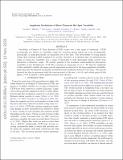Files in this item
Amplitude modulation of short-timescale hot spot variability
Item metadata
| dc.contributor.author | Biddle, Lauren I. | |
| dc.contributor.author | Llama, Joe | |
| dc.contributor.author | Cameron, Andrew | |
| dc.contributor.author | Prato, L. | |
| dc.contributor.author | Jardine, Moira | |
| dc.contributor.author | Johns-Krull, Christopher M. | |
| dc.date.accessioned | 2022-01-14T00:41:31Z | |
| dc.date.available | 2022-01-14T00:41:31Z | |
| dc.date.issued | 2021-01-14 | |
| dc.identifier | 272845478 | |
| dc.identifier | 70ce7461-98ba-4498-8992-a410e4f9e4a9 | |
| dc.identifier | 85100120756 | |
| dc.identifier | 000607748600001 | |
| dc.identifier.citation | Biddle , L I , Llama , J , Cameron , A , Prato , L , Jardine , M & Johns-Krull , C M 2021 , ' Amplitude modulation of short-timescale hot spot variability ' , Astrophysical Journal , vol. 906 , no. 2 , 113 . https://doi.org/10.3847/1538-4357/abc889 | en |
| dc.identifier.issn | 0004-637X | |
| dc.identifier.other | ORCID: /0000-0002-8863-7828/work/88730775 | |
| dc.identifier.other | ORCID: /0000-0002-1466-5236/work/88730888 | |
| dc.identifier.uri | https://hdl.handle.net/10023/24660 | |
| dc.description | Funding Information: L.I.B., L.A.P., and J.L. acknowledge support from NASA through an Astrophysics Data Analysis Program grant to Lowell Observatory (grant 80NSSC20K1001). A.C.C. and M.M.J. acknowledge support from the Science and Technology Facilities Council (STFC) consolidated grant No. ST/R00824/1, and the support of the visiting scientist program at Lowell Observatory in 2019 January and 2020 January. Data were obtained using the Mikulski Archive for Space Telescopes (MAST). STScI is operated by the Association of Universities for Research in Astronomy, Inc., under NASA contract NAS5-26555. | en |
| dc.description.abstract | Variability of Classical T Tauri stars (CTTS) occurs over a vast range of timescales. CTTS in particular are subject to variability caused by accretion shocks, which can occur stochastically, periodically, or quasi-periodically on timescales over a few days. The detectability of young planets within these systems is likely hampered by activity; therefore, it is essential that we understand the origin of young star variability over a range of timescales to help disentangle stellar activity from signatures of planetary origin. We present an analysis of the stochastic small-amplitude photometric variability in the K2 lightcurve of CI Tau occurring on timescales of ≲1 day. We find the amplitude of this variability exhibits the same periodic signatures as detected in the large-amplitude variability, indicating that the physical mechanism modulating these brightness features is the same. The periods detected are also in agreement with the rotation period of the star (∼6.6 days) and the orbital period of the planet (∼9.0 days) known to drive pulsed accretion onto the star. | |
| dc.format.extent | 7 | |
| dc.format.extent | 987022 | |
| dc.language.iso | eng | |
| dc.relation.ispartof | Astrophysical Journal | en |
| dc.subject | QB Astronomy | en |
| dc.subject | QC Physics | en |
| dc.subject | Space and Planetary Science | en |
| dc.subject | Astronomy and Astrophysics | en |
| dc.subject | 3rd-DAS | en |
| dc.subject.lcc | QB | en |
| dc.subject.lcc | QC | en |
| dc.title | Amplitude modulation of short-timescale hot spot variability | en |
| dc.type | Journal article | en |
| dc.contributor.sponsor | Science & Technology Facilities Council | en |
| dc.contributor.institution | University of St Andrews. School of Physics and Astronomy | en |
| dc.contributor.institution | University of St Andrews. St Andrews Centre for Exoplanet Science | en |
| dc.identifier.doi | 10.3847/1538-4357/abc889 | |
| dc.description.status | Peer reviewed | en |
| dc.date.embargoedUntil | 2022-01-14 | |
| dc.identifier.grantnumber | ST/R00824/1 | en |
This item appears in the following Collection(s)
Items in the St Andrews Research Repository are protected by copyright, with all rights reserved, unless otherwise indicated.

